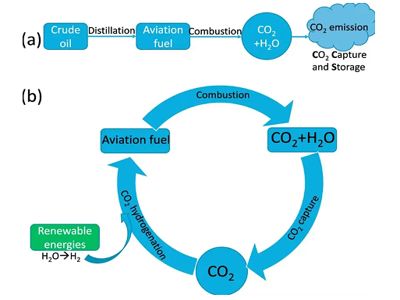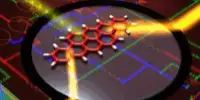A team of scientists from Oxford University has made an unconventional attempt to advocate for renewable energy: to turn carbon dioxide back into jet fuel. A team of researchers at Oxford University have discovered what they believe is a cost-effective and reliable way of processing carbon dioxide jet fuel, and they hope that one day vacationers will be able to take off abroad without the cost—and related guilt—of a heavy carbon footprint.
Researchers unveil new methods for converting carbon dioxide into jet fuel. The experiment could open a new area of research in which the greenhouse gas could be extracted from the air, stored, and used to power planes.
Environmentalists have long claimed that commercial flying affects the atmosphere with the vast volume of CO2 that passenger planes produce globally; air traffic accounts for around 2.5 percent of total carbon dioxide emissions. The dilemma lies in the combustion of fossil fuels, a mechanism that basically takes gas buried under the Earth’s crust and releases it into the atmosphere. The mechanism is expected to lead to global warming.
The technology, Wired says, could help reduce the huge environmental effects of the aviation industry, both by helping to deter carbon dioxide contamination by feeding pollutants into the system and by cleaning up the mechanism for processing jet fuel.

Scaling Up
That said, the importance of the issue and the fact that research works—albeit on a small scale—justifies work on a technology scale, the co-author of the study and Oxford chemist Tiancun Xiao told Wired. Xiao indicates that a jet fuel plant situated right next to a power plant might utilize the carbon emissions instead of allowing them to escape into the air.
Instead of contributing to the volume of fuel in the air, the Oxford experiment would result in “carbon-neutral” emissions from aircraft. Essentially, the jet will expel the gas from the air while on the ground and re-emit it by combustion while in space.
“Climate change is accelerating, and we’ve got huge carbon dioxide emissions,” Xiao said. “There is also an infrastructure for hydrocarbon fuels. This mechanism will help to mitigate climate change and use the new carbon infrastructure for sustainable growth.”
Jet fuel is typically derived from crude oil. It is a hydrocarbon or non-renewable organic compound composed primarily of hydrogen and carbon atoms. Jet fuel is similar to diesel, all of which comes from fossil fuels. However, they undergo various processing procedures, which result in jet fuel becoming heavier, with a lower freezing point and more carbon atoms.
Circular Logic
That would clean up some plants, but it would not allow them to stop burning fossil fuels in the first place, said Oskar Meijerink, SkyNRG’s future fuel lead project.
The best use for this kind of device would be to try to eliminate existing carbon dioxide from the atmosphere, proposed Meijerink, who did not operate on the system. But unique uses aside, the device is promising, said University of Dayton engineer Joshua Heyne, who wasn’t working on the project either, to Wired. That’s, assuming they’re scales.
“This does look different,” Heyne said, “and it looks like it could work.”
Ethanol and biodiesel produced from a wide range of vegetable oils and animal fats are the two most popular forms of biofuels on the market. Oxford researchers used iron oxides, manganese and potassium as a catalyst in the laboratory and incorporated citric acid. Carbon dioxide was first introduced from a canister. Heating this mixture to 300 degrees in the circulating hydrogen produced a liquid that they claim would serve as jet fuel if produced on a scale.
Oxford researchers say that their innovative jet fuel production strategy will be cheaper than other biofuel approaches that have endured a long process and rely on cobalt.















